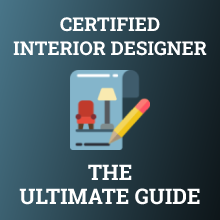Job Description
Interior designers are professionals responsible for making interior spaces safe, functional, and attractive.
They do this by identifying space requirements and choosing decorative elements like colors, furniture, and lighting.
These professionals design the interiors of all kinds of buildings, from residential places to commercial structures.
While some interior designers work for architectural or engineering firms, others work for companies that specialize in design services.
No two interior designers are the same, but it is pretty safe to say that the job entails a great deal of planning, conceptualizing, and material and product sourcing.
Duties
- Determines design objectives taking into account client requirements, budget for the project, and available or accessible materials
- Conceptualizes and drafts design plans
- Budgets project and determine project requirements that fall within the range
- Chooses decorative elements, such as furniture, colors, and lighting
- Sets project completion timeline
- Uses computer applications throughout the design process
- Looks at the design once the project is complete and determines whether all the design goals have been met
Salary
Interior designers make an average of $49,042 per year.
Those on the lower end earn about $39,510, while those on the upper end make around $53,814.
Of course, there are many factors that affect their salary, including certifications, education, relevant skills, and the length of their experience in the profession.
Annually National Average Salary: $68,530
Average Annual Salary by State
| State | Avg. Annual Salary |
|---|---|
| Alabama | $60,840 |
| Arizona | $62,290 |
| Arkansas | $69,990 |
| California | $81,570 |
| Colorado | $69,430 |
| Connecticut | $69,590 |
| Delaware | $48,890 |
| District of Columbia | $92,310 |
| Florida | $64,880 |
| Georgia | $64,880 |
| Hawaii | $62,050 |
| Idaho | $58,890 |
| Illinois | $70,880 |
| Indiana | $60,380 |
| Iowa | $56,820 |
| Kansas | $57,400 |
| Kentucky | $67,920 |
| Louisiana | $51,280 |
| Maine | $51,160 |
| Maryland | $67,110 |
| Massachusetts | $79,310 |
| Michigan | $66,190 |
| Minnesota | $66,090 |
| Mississippi | $49,710 |
| Missouri | $64,320 |
| Montana | $52,680 |
| Nebraska | $55,650 |
| Nevada | $75,240 |
| New Hampshire | $61,320 |
| New Jersey | $69,390 |
| New Mexico | $54,980 |
| New York | $75,310 |
| North Carolina | $59,130 |
| North Dakota | $49,250 |
| Ohio | $55,860 |
| Oklahoma | $55,500 |
| Oregon | $73,650 |
| Pennsylvania | $65,720 |
| Rhode Island | $62,100 |
| South Carolina | $51,330 |
| South Dakota | $66,800 |
| Tennessee | $56,170 |
| Texas | $67,650 |
| Utah | $62,060 |
| Vermont | $72,460 |
| Virginia | $71,770 |
| Washington | $77,240 |
| West Virginia | $51,700 |
| Wisconsin | $58,130 |
| Wyoming | - NA - |
| Puerto Rico | $33,240 |
Annual Average Salary: Top 5 States
The top earning state in the field is District of Columbia, where the average salary is $92,310.
These are the top 5 earning states in the field:
Conducted by: Bureau of Labor Statistics, Department of Labor.
* Employment conditions in your area may vary.
How to Become a Certified Interior Designer: Step-by-Step
Step 1Earn Your Degree
To become a certified interior designer, you must complete a postsecondary program.
You can either obtain your associate’s degree, which will allow you to work as an interior design assistant, or your bachelor’s degree, which will let you work as an entry-level interior designer.
One advantage of getting your bachelor’s degree in interior design is that it can help you reduce the amount of professional experience required.
However, both the associate’s and bachelor’s degrees can qualify you to take the National Council for Interior Design Qualification (NCIDQ) exam, which we will talk about further in step three.
It is important to note that those who plan to practice in the state of California have to take the California Council for Interior Design Certification (CCIDC) exam instead of the NCIDQ exam.
But just like the NCIDQ, the CCIDC requires that you complete college coursework and have work experience.
Step 2Get Professional Experience
No matter which exam you take, you will need to gain work experience.
If you are taking the NCIDQ, you can complete 50% of the required work experience in a bachelor’s degree program.
In the other pathways, you can only complete your work experience after finishing your educational requirements.
Those who are taking California’s interior design certification exam will have to meet certain experience requirements, which they can read on the CCIDC website.
Step 3Pass the Interior Design Certification Exam
Once you have gotten all your education and experience requirements under your belt, you can apply to take your state-approved exam.
The application process differs from state to state, and it is essential that you carefully read the instructions, take note of deadlines, and ensure you have all the required documents and materials.
After the organization has screened your application and verified your eligibility, they will let you know by email when you have been approved to register for your exam.
To earn your certification, you will need to pass all sections of the exam within the allotted time for each one.
The good news is that both the NCIDQ and CCIDC provide a wealth of study resources to help you prepare for the exam.
Make sure you use their resources, which include study guides, practice quizzes, exam tips, and other helpful tools, to your advantage, as these resources will give you a huge upper hand when it is time to take the exam.
Education
As we mentioned before, you must complete a postsecondary program in interior design.
This can be in the form of an associate’s degree or a bachelor’s degree.
Whichever program you choose, it needs to be accredited by the Council for Interior Design Accreditation (CIDA).
Although both the associate’s and bachelor’s degree programs prepare students well for careers in interior design, the bachelor’s program often provides a faster track to certification and employment.
With the bachelor’s program, you can fulfill up to half of the required work experience and become a certified interior designer more quickly.
If you take the associate’s degree route, you will only be able to complete your required professional experience after you have completed your degree.
Job prospects also depend on your degree.
In general, the bachelor’s program provides many more opportunities for advancement.
While the associate’s degree allows you to work as an interior design assistant, the bachelor’s degree lets you work as an entry-level interior designer.
But, again, both are viable options that will get your foot in the door as an interior design professional.
Video About The Career
Licensing & Certification
The certification requirements depend on which type of certification you are pursuing, which depends on your state.
If you live in California, you will need to take the California Council for Interior Design Certification (CCIDC).
Otherwise, you will have to take the exam administered by the National Council for Interior Design Qualification (NCIDQ).
National Council for Interior Design Qualification (NCIDQ)
Those taking the NCIDQ exam will need a minimum of 60 semester hours of postsecondary coursework in interior design.
If you hold a bachelor’s degree and have at least 60 semester hours and 3,520 hours of supervised work experience under your belt, you should be eligible to take the NCIDQ exam.
However, you will still need to complete at least 1,760 hours of work experience after graduation.
When you are ready to take the exam, you will have to complete an online application form and submit payment.
If you take all three test sections together, the cost will be $730.
If you take them separately:
- Section I: $245
- Section II: $205
- Section III: $380
California Council for Interior Design Certification (CCIDC)
Requirements for the CCIDC exam are generally less stringent than those for the NCIDQ exam.
There are four different paths you can apply for, each with different education and work experience requirements.
You should choose the path that best matches your education and experience.
The path with the lowest requirements would be Path 1.
This path requires a minimum of 40 units or five years of diversified design experience.
When you submit your application, you will need to pay a fee of $700.
Once you have passed the exam and your application has been approved, you will be asked to pay your first two years’ fees.
Average Training Program Duration: 2-4 Years
Popular Programs
Job Outlook
According to the US Bureau of Labor Statistics, the employment of interior designers is expected to show little to no change over the next decade.
But even with limited employment growth, we expect to see an average of about 7,800 job openings for interior designers each year until 2030.
The majority of these openings will most likely result from interior designers either switching occupations or retiring.
All in all, if you complete all your education and work experience requirements and obtain state-approved certification, you should have no trouble finding work as an interior designer over the next several years.
Employment Growth Projection: 0%
2020
2030
That's a higher than average projected growth of -100 jobs.
Certified Interior Designer: Interest Over Time
Should You Become an Interior Designer?
Overall Satisfaction: High

A report by CareerExplorer shows that interior designers have greater career satisfaction than people in most other occupations.
They rate their job happiness 3.5 out of 5 stars, putting themselves in the top third of careers.
Their happiness is measured by several factors, including their happiness with their salary, how meaningful they find their jobs, personality fit, work environment, and skills utilization.
Overall, it appears that interior designers find their jobs very meaningful and are quite satisfied with their careers.
Average Salary: High

The average annual salary for interior designers is $49,042, with a range falling between $39,510 and $53,814.
Many factors influence how much they earn, such as education, certifications, relevant skills, and the length of their experience in the profession.
For example, someone with a bachelor’s degree in interior design will generally earn much more than a person with an associate’s degree in the same field.
After all, the bachelor’s degree holder will be qualified to work as an entry-level interior designer, unlike the latter, which will be qualified to work as an interior designer assistant at best.
Job Growth Outlook: Low

According to the US Bureau of Labor Statistics, there will be little to no change in the employment of interior designers over the next decade.
But despite the limited employment growth, we predict that we will see an average of around 7,800 job openings for interior designers every year until 2030.
Most of these openings will result from interior designers either retiring or switching occupations.
If you are certified in interior design, you should have no trouble finding a job in the field, at least over the next several years.
Education Duration: 2-4 Years

Before you can apply for certification, you will need to complete some postsecondary education in the form of a bachelor’s degree or associate’s degree program in interior design.
While most associate’s degree programs last two years, the majority of bachelor’s degree programs take four years to complete.
But even after you have completed your education, you will still need to complete additional hours of supervised work experience, with the number of post-graduation work hours depending on your education program.
Personal Skills Needed

Some of the most essential skills and qualities include an eye for detail, artistic creativity, excellent interpersonal skills, knowledge of computer applications, and organizational skills.
You will also need to be up to date on design trends since they are constantly changing.
And because it is becoming increasingly common for clients to ask for eco-friendly homes and features, you will need to have a decent working knowledge of sustainable practices and eco-friendly design features and technology.
Frequently Asked Questions
Q. How long do you have to go to school to become an interior designer?
It depends on which education program you choose.
Bachelor’s degree programs in interior design usually take four years to complete, while associate’s degree programs in the same field take two years to finish.
However, bachelor’s degree holders generally have to complete fewer post-graduation work experience hours than associate’s degree holders.
You should also bear in mind that your choice of education program will affect your employment prospects.
Those with bachelor’s degrees and proper certification are qualified to work as entry-level interior designers, while people with associate’s degrees and certification can work as interior designer assistants at best.
Nevertheless, both degree programs qualify you to take the NCIDQ exam, which will open the doors for a career in interior design.
Q. How much money does an interior designer make a year?
There is a number of factors that affect an interior designer’s salary, including their education, skills, certifications, and amount of experience in the field.
For instance, a person with a bachelor’s degree in interior design will generally make more than someone with an associate’s degree in the same discipline.
That is because employment prospects are overall much better for bachelor’s degree holders.
In the US, the average salary for interior designers is $49,042 per year.
Those on the upper end earn about $53,814, while those on the lower end make $39,510.
Q. What kind of education do you need to be an interior designer?
Interior designers, at least certified ones, need to complete postsecondary education.
The most common ways to do this are through bachelor’s and associate’s degree programs, which typically last two to four years, depending on your program.
Most postsecondary education programs in interior design involve completing work experience hours prior to graduation.
And even after you have graduated, you still have to complete a certain number of work experience hours while under supervision.
Q. Are interior designers in high demand?
The demand for interior designers is about average.
A report by the US Bureau of Labor Statistics shows that the employment of interior designers is expected to show little to no change over the next decade.
But, the good news is that we still expect to see an average of around 7,800 job openings for interior designers every year until 2030.
So, if you are looking for a job in interior design over the next decade, you should have no trouble finding one, as long as you have all the right qualifications.
Q. What skills do you need to have to be an interior designer?
Not everyone can perform the job of an interior designer, and that is why it is important to have a certain set of skills.
These skills include artistic creativity, an eye for detail, strong interpersonal skills, organizational skills, and knowledge of computer applications.
You should also be up to date on design trends, which constantly change.
Lastly, because it is becoming more and more common for clients to request eco-friendly homes and features, you must have a decent knowledge of sustainable practices as well as eco-friendly design features and technology.









